![Online Dating Statistics [Complete Overview]](https://wp.bedbible.com/wp-content/uploads/2022/09/online-dating-statistics.png)
Interested in the world of online dating? Our comprehensive report offers a deep dive into the latest trends and insights. We cover user demographics, how couples meet, and the goals and interests of online daters. Explore industry statistics, market competition, and seasonal trends. Learn about truthfulness in profiles, challenges faced by both women and men, and opinions on online dating. We also tackle the darker side, from negative experiences to data leaks and hacking.
Discover everything you need to know about online dating today!
Here’s what you can find in this article:
- User data
- How couples met
- Matches, Goals, and interests
- Online Dating Industry and Market Statistics
- Competition and market share
- Seasonal Trends in Online Dating
- Truthfulness – Lying on Online Dating Profiles
- Challenges Women Encounter in Online Dating
- Challenges Men Face in Online Dating
- How do people find online dating, do they like it?
- Negative aspects of online dating
- Data Leaks and Hacking
Key Takeaways
- 67.7% have at some point tried an online dating service.
- 44% of couples have met through online dating.
- In 2023 there were 326 million active dating users worldwide and is expected to reach 500 million by 2030.
- 21 million online dating profiles are hacked and leaked on average each year.
- Tinder’s annual revenue is larger than the total revenue of the entire US online dating market ($1.9B).
- 71% of all homosexual couples found each other online.
- 27% of men are looking for something sexual on dating platforms (13% of women) and 73% of men are looking for something romantic (87% of women).
- 19% of online daters have never met anyone in person.
- $6.2B in revenue is generated every year by online dating.
- The online dating industry is projected to turnover $12.7B by 2030.
- Covid-19 resulted in a 175% increase in annual revenue from online dating (2019-2022).
- The online dating market in the US alone is worth $1.64 billion annually.
- 34.6% of Americans are currently on a dating platform.
- German online dating users spend the most on average ($31 per user).
- The largest dating app, Chinese Tantan, has 4.5 times more users (361.3 million) compared to Tinder (81.1 million).
- Tinder is the worlds most profitable dating app turning over $1.89 billion last year, earning an average of $23 per user with more than 51% of users paying to use the app.
- Match Group is the largest online dating conglomerate (owning Tinder, Match.com, OkCupid, and more) with annual revenue of $3.2 billion, and profits of $820 million.
- More than 2 million Americans report being catfished each year.
- An estimated 10% of all dating profiles are fake.
- Romance scams centered around online dating services account for $304 million in annual losses for Americans.
- 72% of online dating users have blocked someone in the past six months.
- 21 million online dating profiles are hacked and leaked each year.
User data
In this section, we will cover all the findings on a “user” level, such as demographic differences, sexuality, dating and meetups, marriages, and much more. Let’s start off with the basics:
How many users, have tried, or find online dating interesting?
- 29.3% are currently on a dating site or app.
- 37.4% have formerly been on a dating site or app.
- 32.3% have never used it.
- 1.0% did not want to answer.
- Of the 32.3% that have never used a dating site or app 31.3% have “thought about it”
- In total, only 22.9% have never used or thought about using an online dating service.
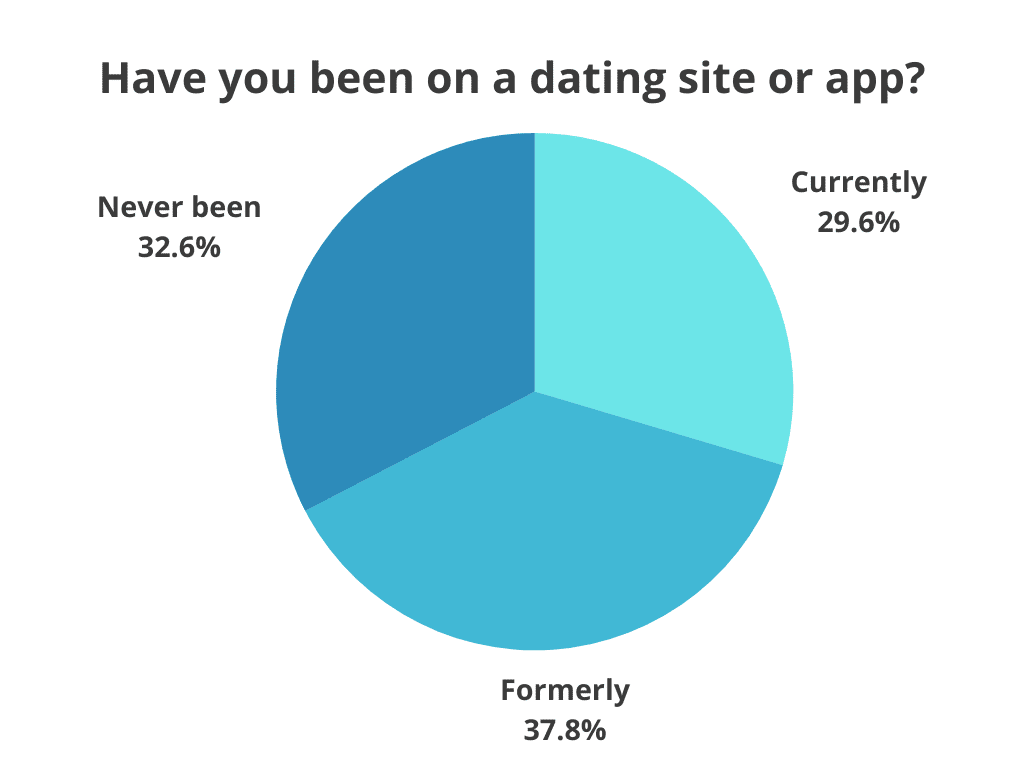
How couples met
With the growing use of online dating platforms comes a growing number of couples, that have met through online dating.
- An estimated 46% of couples in 2023 have met through online dating.
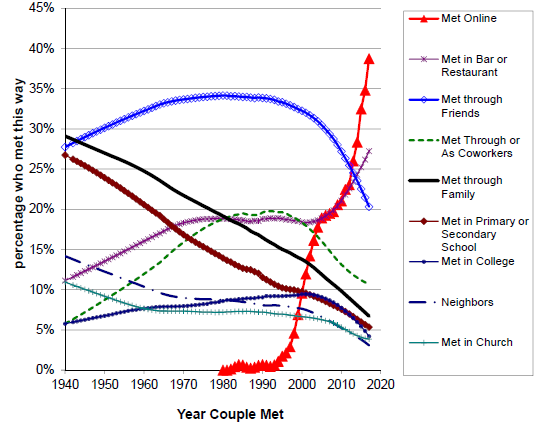
We suspected, that gender, sexuality, and age would have a big impact on if people met online or not.
However, we were surprised to find this big of a difference.
For example, when we asked people only to choose one reason they met as the one that primary reason, and compared that to their current age the results show the same trends as before, but also reveal some interesting perspectives:
- 46% of couples in 2023 have met online.
- More than 65% of couples under 30 have met online.
- It is most common for couples over 60 to have met through family.
- Couples in their 30’s are the most likely age group to have met in bars or restaurants.
- Couples in their 50’s are the age group that are most likely to have met their partner in school.
By age
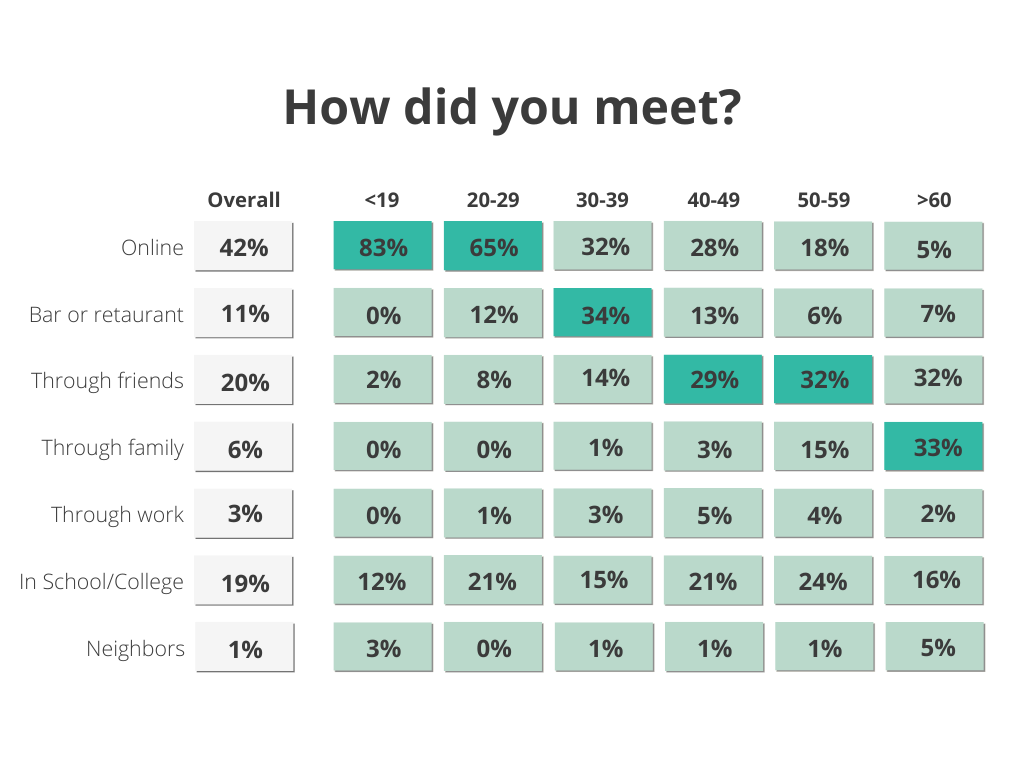
| Overall | <19 | 20-29 | 30-39 | 40-49 | 50-59 | >60 | |
|---|---|---|---|---|---|---|---|
| Online | 42% | 83% | 65% | 32% | 28% | 18% | 5% |
| Bar or retaurant | 11% | 0% | 12% | 34% | 13% | 6% | 7% |
| Through friends | 20% | 2% | 8% | 14% | 29% | 32% | 32% |
| Through family | 6% | 0% | 0% | 1% | 3% | 15% | 33% |
| Through work | 3% | 0% | 1% | 3% | 5% | 4% | 2% |
| In School/College | 19% | 12% | 21% | 15% | 21% | 24% | 16% |
| Neighbors | 1% | 3% | 0% | 1% | 1% | 1% | 5% |
By sexuality
However, we also found, that when we isolated the numbers, so that they only took into account homosexual couples the online dating scene was much larger and became popular faster.
- 71% of all homosexual couples found each other online.
- More than 93% of homosexual couples under 30 have found each other through online dating.
- Homosexual couples are 69% more likely to have met online compared to all other couples.
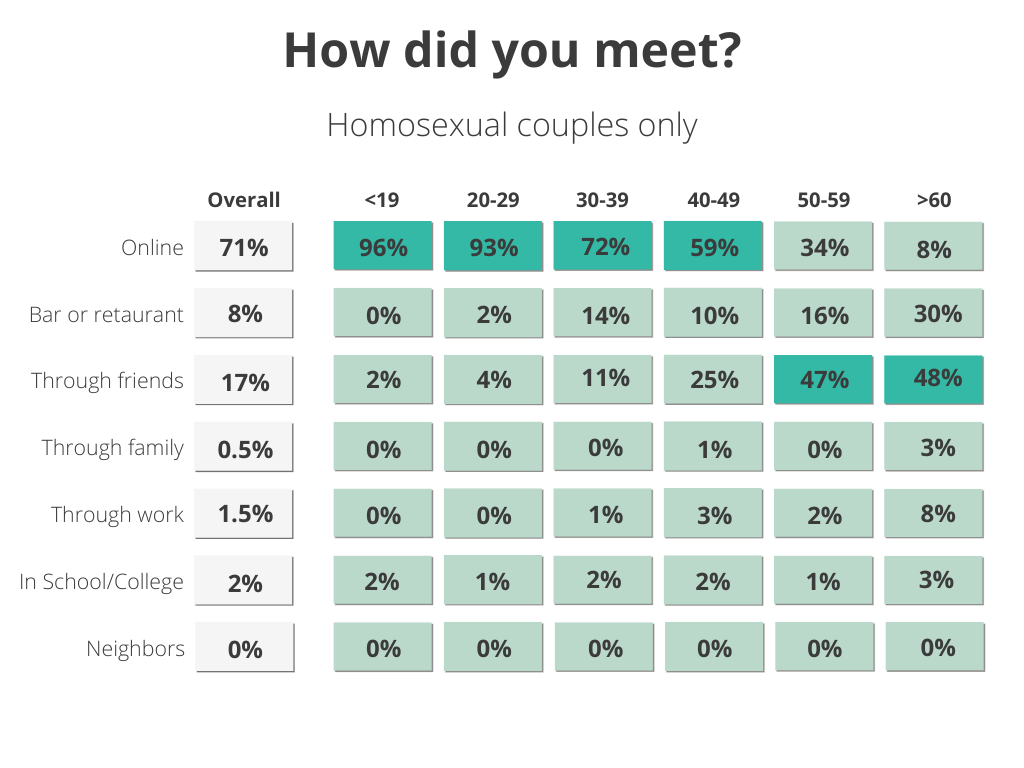
Matches, Goals, and interests
First of, we looked into why people reported to use online dating, and what reasoning they had for meeting people.
For example, if we have a look at if online daters are looking for something romantic versus something sexual.
Why do people use online dating and meet?
- 80% of people on online dating platforms are looking for something romantic, while 20% are looking for something sexual.
- 27% of men are looking for something sexual on dating platforms and 73% are looking for something romantic.
- 87% of women are looking for something romanting on dating platforms, and 13% are looking for something sexual.
- 18-29 year olds are the most likely age group to look for friendships on online dating platforms (19%).
- The older you get, the more likely you are to primarily look for something long-term on dating platforms – 36% of +55 year olds look for something romantic compared to just 22% of 18-29 year olds.
| Reason | Total | % of Men | % of Women | | | 18-29 years | 30-44 years | 45-54 years | 55-64 years |
|---|---|---|---|---|---|---|---|---|
| A long-term romance | 30% | 30% | 29% | | | 22% | 33% | 31% | 36% |
| To go on 1+ date(s) | 40% | 34% | 47% | | | 35% | 40% | 50% | 39% |
| Friendship | 12% | 12% | 13% | | | 19% | 11% | 4% | 9% |
| To Hookup | 18% | 24% | 11% | | | 24% | 17% | 14% | 15% |
| – | – | – | – | – | – | – | – | – |
| Looking for romance | 80% | 73% | 87% | | | 70% | 81% | 85% | 84% |
| Looking for sexual | 20% | 27% | 13% | | | 30% | 19% | 15% | 16% |
How many meet? And how many do they chat with?
- 19% of online daters have never met anyone in person.
- 8% of online daters have not been in contact with anyone on the platform.
- 17% of men report that they never met anyone from online dating, while 24% of women report not meeting anyone.
- 81% of people have been on a date with someone they met from online dating.
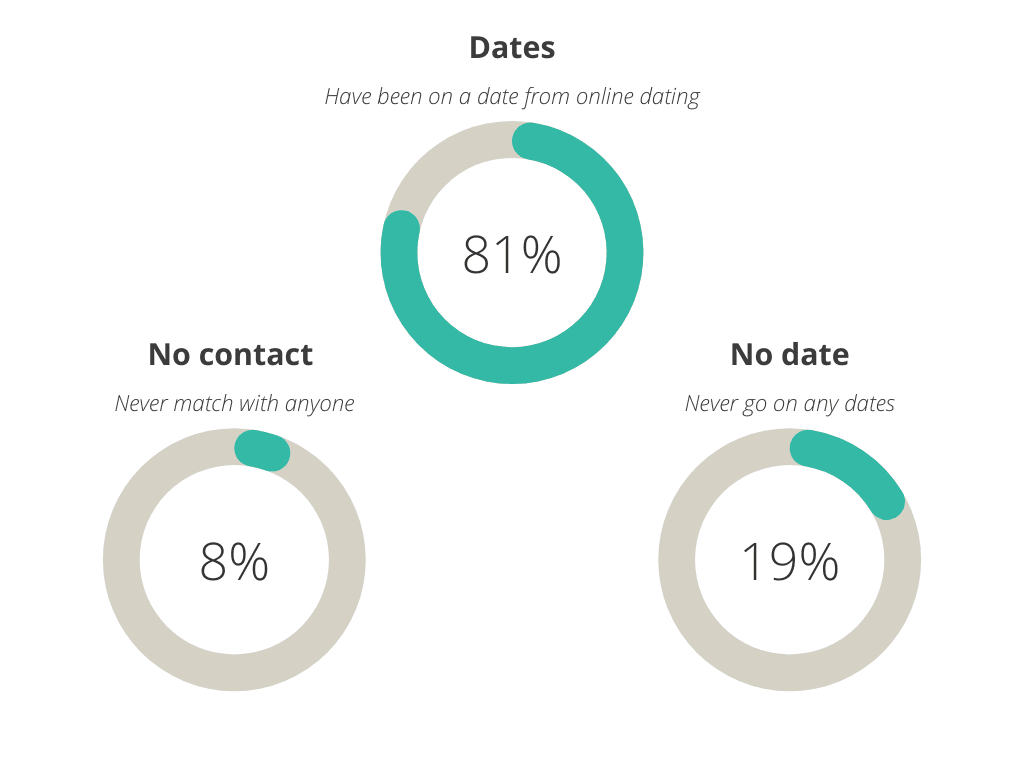
Preferences on dating apps
Obviously, preferences will likely differ between different online daters and especially on the fast growing and popular dating apps. So we asked respondents to give an answer to what they prefer:
- 61% use dating apps to find people with common interest.
- 44% use dating apps to find people who share their values.
- 42% use dating apps to find someone to marry.
- 26% use dating apps to find people to meet for fun.
- 21% report to use dating apps due to having a tight schedule.
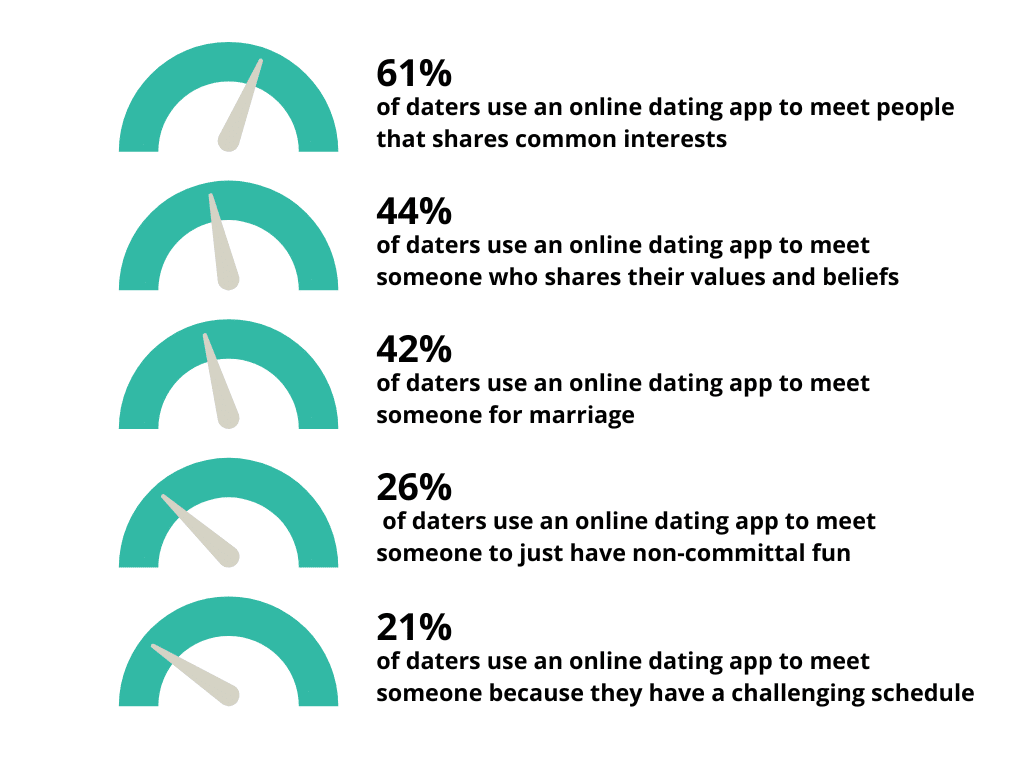
Online Dating Industry and Market Statistics
In this section we will cover all the data related to revenue, market share, profits, growth, and trends within the online dating industry.
With access to survey data and online platform user data the following estimates and predictions are the most precise to date.
Worldwide online dating users
- In 2021 there were 323 million active dating users worldwide.
- The number of worldwide dating have grown to 331 million users in mid-2023 and is expected to reach 343.9 million.
- The number of worldwide dating users is expected to reach over 500 million by 2030 with a +5% yearly growth.
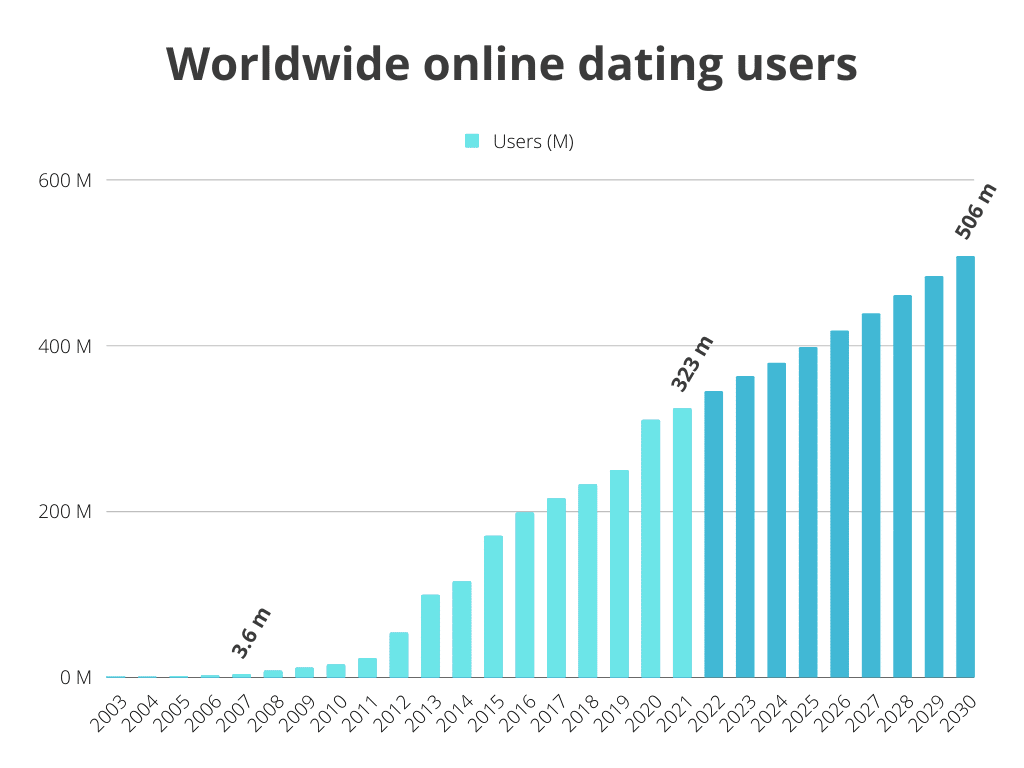
Online dating revenue worldwide
- The online dating industry is projected to turnover $12.7B by 2030.
- $6.2B in revenue was generated by online dating in 2021.
- Up until 2010, revenue generated through websites was higher than on Mobile Apps
- Covid-19 resulted in a 175% increase in annual revenue from online dating (2019-2022).
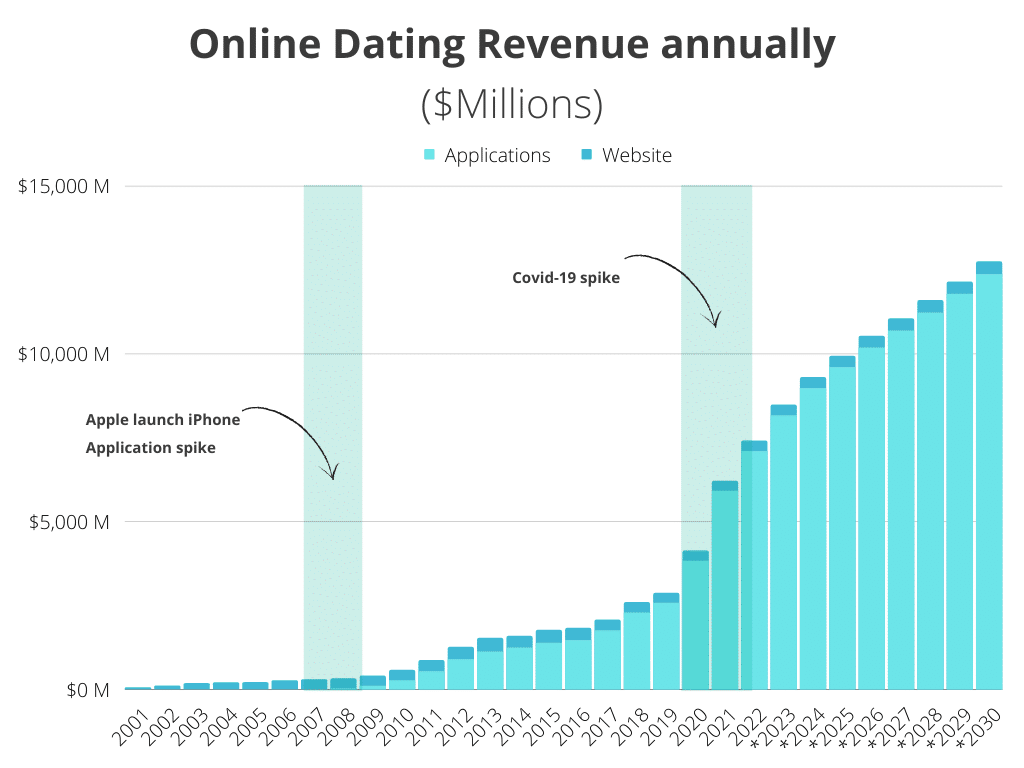
Covid-19 caused a bigger spike in expenditure per user compared to the average. :
- A online dating user spends on average $10 per year on online dating platforms.
- During Covid-19 the average spending per user increased to $19 per year (from $10).
- Therefore, the main benefactor towards the incredible revenue growth inthe online dating market can be attributed to the average spend per user increasing +90%
| Year | App (Revenue, $million) | Website (Revenue, $million) | Total (Revenue, $million) |
|---|---|---|---|
| 2001 | 0 | 42 | 42 |
| 2002 | 0 | 92 | 92 |
| 2003 | 0 | 163 | 163 |
| 2004 | 0 | 188 | 188 |
| 2005 | 0 | 192 | 193 |
| 2006 | 0 | 249 | 250 |
| 2007 | 3 | 277 | 280 |
| 2008 | 32 | 285 | 317 |
| 2009 | 107 | 295 | 402 |
| 2010 | 268 | 305 | 573 |
| 2011 | 537 | 326 | 863 |
| 2012 | 894 | 365 | 1259 |
| 2013 | 1118 | 412 | 1530 |
| 2014 | 1242 | 345 | 1587 |
| 2015 | 1380 | 388 | 1768 |
| 2016 | 1460 | 363 | 1823 |
| 2017 | 1750 | 323 | 2073 |
| 2018 | 2280 | 313 | 2593 |
| 2019 | 2570 | 301 | 2871 |
| 2020 | 3820 | 311 | 4131 |
| 2021 | 5910 | 299 | 6209 |
| 2022 | 7092 | 315 | 7407 |
| 2023 | 8156 | 323 | 8479 |
| *2024 | 8971 | 328 | 9299 |
| *2025 | 9599 | 333 | 9932 |
| *2026 | 10175 | 354 | 10529 |
| *2027 | 10684 | 364 | 11048 |
| *2028 | 11218 | 373 | 11591 |
| *2029 | 11779 | 365 | 12144 |
| *2030 | 12368 | 377 | 12745 |
Market share per country
We had a look at the age group (18-60) by countries and found that:
- The US is the most active country when it comes to online dating with 34.6% of 18-60 year olds currently on a dating platform, while 72.4% have at one point tried (or is trying) it.
Top 5 Countries by Penetration
In each parenthises we listed: (+ %-have been on, = %-who at one point have tried or is currently on a dating platform)
- United States – 34.6% currently on a dating platform (+ 37.8%, = 72.4%)
- United Kingdom – 31.4% currently on a dating platform (+ 32.7%, = 64.1%)
- Belgium – 31.4% currently on a dating platform (+ 31.3%, = 62.7%)
- Netherlands – 30.1% currently on a dating platform (+31.4, = 61.5%)
- Luxembourg – 30.1% currently on a dating platform (+29.9, = 60.0%)
Top 5 Countries by Revenue (annually)
- United States – $1.64 billion
- China – $1.15 billion
- India – $387 million
- United Kingdom – $369 million
- Germany – $303 million
Top 5 Countries by Revenue (annually), Per User
- United States – $21.2 per user
- China – $9.1 per user
- India – $2.3 per user
- United Kingdom – $29 per user
- Germany – $31 per user
Competition and market share
With more than 3900 different dating apps and services we set out to pinpoint the biggest by market share by the number of users, revenue, percentage of paying users, growth and much more. Here is what we found:
Most Users: Top 10 online dating services
- Tantan has 361.3 million users
- Tinder has 81.1 million users
- Badoo has 69.9 million users
- Bumble has 44.4 million users
- Hinge has 27.3 million users
- PoF has 16.1 million users
- Grindr has 15.2 million users
- Happn has 15.2 million users
- Match has 11.7 million users
- OkCupid has 6.9 million users
Most Revenue: Top 10 online dating services
- Tantan made $53.9 million in revenue last year (~$0.15 per user, China)
- Tinder made $1.89 billion in revenue last year (~ $23 per user, worldwide)
- Badoo made $58.1 million in revenue last year (~ $1.2 per user, worldwide)
- Bumble made $765 million in revenue last year (~ $17.2 per user, worldwide)
- Hinge made $197 million in revenue last year (~ $7.2 per user, worldwide)
- PoF made $101 million in revenue last year (~ $6.3 per user, worldwide)
- Grindr made $147 million in revenue last year (~ $9.7 per user, worldwide)
- Happn made $15 Million in revenue last year (~ $1.01 per user, worldwide)
- Match.com, N/A (~ XX per user, worldwide)
- OkCupid made $29.1 million in revenue last year (~ $4.2 per user, worldwide)
Largest Percentage of Paying Customers: Top 10 online dating services
- 51% – Tinder
- 32% – Bumble
- 31% – Match
- 28% – eharmony
- 24% – OkCupid
- 21% – PoF
- 20% – Hinge
- 17% – Grindr
- 15% – Badoo
- 15% – Coffee Meets Bagel
Most Monthly Downloads: Top 10 online dating services
- 6.4 million – Tinder
- 3.3 million – Badoo
- 1.8 million – Bumble
- 867 thousand – Happn
- 554 thousand – Hinge
- 448 thousand – OkCupid
- 279 thousand – Match
- 118 thousand – Inner Circle
- 84 thousand – Coffee Meets Bagel
- 81 thousand – eharmony
One to rule them all – Match Group LLC
Maybe unknown to most, but in the world of online dating there is a conglomerate that owns almost every successful dating app or website in the world. It started as one of the first dating websites, by the name of Match.com. Our researchers have found some interesting statistics on Match Group:
- Match Group made $3.20 Billion in revenue last year.
- Match Group made a profit of $820 million last year.
- Match Group owns Tinder, Match.com, Meetic, OkCupid, Hinge, PoF, Pairs, OurTime, Ship, and many more.
- Match Group on average managed to increase their revenue by +15-25% each year.
- Match Group owns the highest-grossing app worldwide (Tinder).
- Match Group has 2,540 employees but has previously had more than 9,100 employees in 2016.
Seasonal Trends in Online Dating
Do our online dating behaviors align with the changing seasons?
Humans, much like other creatures, exhibit seasonal patterns in their dating habits.
Peak Dating Months
Match.com suggests that the winter months, spanning from December to February, witness the highest activity on dating platforms.
This surge is attributed to the phenomenon known as “cuffing season.”
Understanding Cuffing Season
If you’re unfamiliar with the term, cuffing season refers to the period when individuals seek companionship, primarily driven by the desire to stay indoors and cozy up with someone during the colder months.
Cuffing Season 2023: A New Twist
The concept of cuffing season has taken a fresh turn in 2023.
Enter “Winter Coasting,” a trend where individuals reconnect with past partners, hoping to reignite old passions to stay warm in the winter.
A survey conducted by the dating app Inner Circle revealed that 52% of UK singles had been approached by an ex with intentions to rekindle.
However, a word of caution: 71% of these attempts didn’t result in a successful reunion.
Additional Insights
- Seasonal Trends: Our research on popular dating apps in the U.S., including Tinder, Plenty of Fish, Zoosk, and Bumble, revealed that these apps’ combined sessions were 14% higher during the winter months (November to February) compared to the summer months (May to August). However, the data varies when broken down by individual apps.
- February’s Surprising Decline: Contrary to expectations, most dating apps experienced a decline in engagement and downloads in February, despite the proximity to Valentine’s Day. For instance, Tinder saw a 14.5% decrease in downloads and a 10.3% drop in sessions during this month. Bumble, however, had its best day in terms of in-app purchase revenue on February 13th.
- Summer’s Declining Interest: As summer transitions to fall, there’s a noticeable decline in the download numbers for most dating apps. For example, Bumble’s monthly downloads decreased nearly 20% between May and August 2023. However, Hinge was an exception, with its monthly download figures almost doubling during the same period.
Truthfulness – lying on Online Dating Profiles
- Over 53% of Americans lie on their dating profile
- 73% think that their friends present inaccurate information or images on their dating profiles.
- Only 54% of online dating users classify themselves as single.
- 20% of women used pictures of themselves at a +5 year younger age.
- 40% of men report having lied about jobs or finances.
While most men lie about their height, most women lie about their weight. Both genders have a tendency to lie about their age on their online dating profiles.
Challenges Women Encounter in Online Dating
Although there’s a higher male presence in online dating, it doesn’t necessarily benefit women as one might initially think.
This dynamic leads to a phenomenon researchers term a “feedback loop,” which unfolds as follows:
Men frequently swipe right, aiming to increase their match count, while women tend to be more selective.
As a result, women often invest more emotionally in their matches.
On the other hand, men, aiming to play the numbers, send out numerous messages but often lack the commitment to nurture genuine connections.
Experiencing Harassment
Online dating platforms unfortunately expose women to a higher degree of harassment compared to men.
For instance, a study by the Pew Research Center revealed:
- Among female users aged 18 to 34, 60% stated that someone on a dating platform persisted in contacting them even after they expressed disinterest.
- 57% of women have received unsolicited sexually explicit messages or images.
Naturally, there are challenges inherent to online dating that affect individuals regardless of gender.
Challenges Men Face in Online Dating
Disproportionate demographics:
Online dating platforms tend to have a higher number of male users compared to female users.
This trend is consistent across various dating apps and websites.
For instance, Bumble boasts a relatively balanced user base with 43% women and 57% men.
On the other hand, Tinder’s user distribution is highly skewed.
A 2021 survey indicated that nearly 80% of its users are male, translating to a 4:1 male-to-female ratio.
Such a disparity intensifies competition among male users and leads to the next point…
Heightened Selectivity Among Women
Given the imbalanced user ratio, it’s logical that women receive more attention and, consequently, can afford to be more selective.
An intriguing experiment set up fake male and female profiles to gauge match rates.
The results were telling: the fabricated female profile had a match rate of 10.5%, while the male counterpart secured a mere 0.6%.
This phenomenon, often referred to as the “paradox of choice” in online dating, encourages continuous swiping and delays decision-making for all users.
How do people find online dating, do they like it?
Online dating’s increasing prevalence might suggest a general fondness for it, but the sentiment is more nuanced.
Attitudes Towards Online Dating
Mixed Feelings
While online dating’s growth indicates its acceptance, it doesn’t necessarily mirror our multifaceted emotions towards it.
A study revealed that approximately 60% of participants had positive encounters on dating platforms.
However, contrasting data from another survey highlighted that 84% of Millennials would prefer meeting someone offline rather than online.
Relationship Status with Online Dating: “It’s Complicated”
Online dating is akin to a double-edged sword.
On one side, it offers a convenient avenue to explore romance and connect with new individuals.
On the flip side, it’s not devoid of challenges, drawbacks, and potential pitfalls.
Negative aspects of online dating
On top of looking at statistics related to the general online dating market as well as specific user data and behavior statistics, we took a deep dive into the negative consequences of a growing online dating market.
We had a look at everything from scams, catfishing, feelings of safety, frustration, insecurity, hopelessness, and lonesomeness to how truthful people are on their dating profiles and how many times they have received inappropriate messages or even how many times they have had to block others.
Catfishing
Catfishing only really became a widespread problem with the development of the online dating market.
And when we looked into the data it showed some interesting catfishing statistics:
- 2.06 million people report being the victim of catfishing each year in the US.
- 64% of people who catfish others are women.
- 1 out of 4 change gender when catfishing.
- An estimated 10% of all online dating profiles are fake (catfishes).
- Alaska has the highest number of reported catfishing cases per capita.
- 83 million profiles on Facebook are estimated to be fake.
- 35% of catfishing victims report significant psychological consequences.
- Catfishing is often the center for money scams and has caused an estimated $304 million in losses.
- An estimated 35% of catfish use the scam for profit, while the rest report differing reasons; confidence, loneliness, love, excitement, and revenge.
- 20% of men who have been catfished admitted that they were tricked more than five times before.
Security – Feared for safety while online dating
When asking online daters about how secure and safe they feel while online dating we were taken aback by the answers.
- 70% of people reported having worried about their safety while using an online dating service.
- 55% reported that they know someone who had an unsafe experience with an online dating service.
- The most prevalent safety concerns people cite are:
- Fake accounts (67%)
- Money scams (55%)
- Sexual harassment (29%)
- Verbal harassment (27%)
- Stalking (20%)
- 72% have blocked another user at least once in the past six months.
Negative emotions
For all the good that online dating brings, many online daters also report negative emotions.
- 40% had an overall negative experience with online dating.
- 30% of women report feeling overwhelmed by too many messages.
- 57% of men report feeling unattractive due to too few messages.
- 25% report being bullied or harassed.
- 48% report receiving explicit messages and images they did not ask for.
- 61% report feeling frustrated with online dating.
- 55% report feeling pessimistic about online dating.
- 44% report feeling insecure about online dating.
Data Leaks and Hacking
Hacking and data leaks are very common, but often not reported widely enough. Compared to other data leaks dating service databases are more private than most others and leaks are more impactful. Unfortunately, dating apps and services have become a popular target to use for sextortion or other extortion scams.
First, some key statistics on hacking and data leaks within online dating:
- 55% report believing a hacker gained access to their profile data or messages.
- 209,452,689 user profiles have been leaked since 2011 (and that is only those publicly available).
- 21 million online dating profiles are hacked and leaked on average each year.
- Tinder keeps an average of 800 pages of information per user.
Second, let’s take you through the public data leaks since 2011:
2011: Zhenai.com, 5,024,908 user profiles
Despite very hard access to public records multiple sources claim to have seen the leaked data of more than 5 million Chinese dating profiles emails and passwords. However, the alleged hacking has still not been verified.
- Breach date: 21 December 2011
- Compromised accounts: 5,024,908
- Compromised data: Email addresses, Passwords
2011: Zoosk.com, 52,578,183 user profiles
The hacking and leaking of more than 52.5 million dating profiles from Zoosk.com in 2011 has since been verified to be a fabricated attempt to sell the data online. However, Zoosk did later fail the trust of its users in 2020 (read on).
- Breach date: 1 January 2011
- Compromised accounts: 52,578,183
- Compromised data: Email addresses, Passwords
2015: BeautifulPeople.com, 1,100,089 user profiles
Beautiful People claimed to be a dating site where every profile was vetted and ranked on how beautiful they were. This sparked the interest to hack the site from dark corners of the internet, which culminated with the leak of 1.1 million profiles in 2015.
- Breach date: 11 November 2015
- Compromised accounts: 1,100,089
- Compromised data: Beauty ratings, Car ownership statuses, Dates of birth, Drinking habits, Education levels, Email addresses, Genders, Geographic locations, Home ownership statuses, Income levels, IP addresses, Job titles, Names, Passwords, Personal descriptions, Personal interests, Physical attributes, Sexual orientations, Smoking habits, Website activity
2016: JustDate.com, 24,451,312 user profiles
Some controversy exists around if the data that was supposedly leaked from a hacking of JustDate.com is in fact just manufactured for the purpose of trying to resell it.
- Breach date: 29 September 2016
- Compromised accounts: 24,451,312
- Compromised data: Dates of birth, Email addresses, Geographic locations, Names
2016: Mate1.com, 27,393,015 user profiles
This is one of the largest data leaks, with the most available data points. Most critical passwords were stored in plain text and were able to be matched with email addresses.
- Breach date: 29 February 2016
- Compromised accounts: 27,393,015
- Compromised data: Astrological signs, Dates of birth, Drinking habits, Drug habits, Education levels, Email addresses, Ethnicities, Fitness levels, Genders, Geographic locations, Income levels, Job titles, Names, Parenting plans, Passwords, Personal descriptions, Physical attributes, Political views, Relationship statuses, Religions, Sexual fetishes, Travel habits, Usernames, Website activity, Work habits
2017: Muslim Match, 149,830 user profiles
A Muslim online dating service had its almost 150k members’ profiles hacked and leaked in the summer of 2017. Passwords were fortunately still hashed with MD5, and therefore not accessible to the hackers.
- Breach date: 24 June 2017
- Compromised accounts: 149,830
- Compromised data: Chat logs, Email addresses, Geographic locations, IP addresses, Passwords, Private messages, User statuses, Usernames
2017: Shadi.com, 2,021,984 user profiles
In what seems liked targeted attacks on Muslim dating services Shadi.com was also breached in the summer of 2017. The hackers successfully managed to retrieve more than 2 million accounts with emails and passwords, before the vulnerability was closed.
- Breach date: 9 July 2017
- Compromised accounts: 2,021,984
- Compromised data: Email addresses, Passwords
2019: Jcrush, 200,000 user profiles
In an uncovering by security researchers Noam Rotem and Ran Locar, it was found that at least 200,000 user profiles had been hacked and leaked online. JCrush is owned by Northsight Capital, Inc..
- Breach date: 6 January 2019
- Compromised accounts: aprox. 200,000
- Compromised data: First and Last names of users, Email addresses, Facebook tokens (which can be used for log in), Full user profiles, Profile pictures, Private – sometimes very intimate – messages and sensitive photos sent in those messages, How many ‘swipes’ a user received per month, When and where they last logged in from.
2019: CatholicSingles.com, 50,000 user profiles
The hacking of an Amazon Bucket server on which at least 50,000 user profiles from the catholic focused dating site, CatholicSingles.com, was located lead to the leaking a database of 17 MB containing names, adresses and more.
- Breach date: 12 July 2019
- Compromised accounts: aprox. 50,000
- Compromised data: User’s real names, email addresses, phone numbers, billing addresses, and more.
2020: MobiFriends, 3,512,952 user profiles
The dating app, with offices in Barcelona, was breached in early 2020 by a hacker who only identified himself by his email: white_peacock@riseup.net. Passwords in the dataset were hashed and not available.
- Breach date: 6 January 2020
- Compromised accounts: 3,512,952
- Compromised data: Dates of birth, Email addresses, Genders, Passwords, Usernames
2020: Zoosk, 23,927,853 user profiles
In early 2020, in a wave of online dating service hacking, Zoosk also became a target and has since became one of the most widely spread leaks of data from any online dating service hacking.
- Breach date: 12 January 2020
- Compromised accounts: 23,927,853
- Compromised data: Dates of birth, Drinking habits, Education levels, Email addresses, Ethnicities, Family structure, Genders, Geographic locations, Income levels, Names, Nicknames, Physical attributes, Political views, Relationship statuses, Religions, Sexual orientations, Smoking habits
2020: MeetMindful, 1,422,717 user profiles
Zdnet.com was first on the story after almost 1.4 million user profiles from MeetMindful was leaked on the dark web.
- Breach date: 26 January 2020
- Compromised accounts: 1,422,717
- Compromised data: Dates of birth, Drinking habits, Drug habits, Email addresses, Genders, Geographic locations, IP addresses, Marital statuses, Names, Passwords, Physical attributes, Religions, Sexual orientations, Smoking habits, Social media profiles, Usernames
2020: +70 adult dating websites, 66,512,812 user profiles
In a widespread hacking of the mailservice, Mailfire, +70 adult dating website had 4 days of messages, profile data and notifications, making up more than 370 million records.
- Breach date: 26 January 2020
- Compromised accounts: 66,512,812
- Compromised data: Full names, Age and date of birth, Gender, Email addresses, Locations of senders, IP addresses, Profile pictures uploaded by users, Profile bio descriptions
2021: Atraf, 1,107,034 user profiles
The Israile hosting provider CyberServe was hacked by a group with the name “BlackSnow”. One site that was caught in this hacking was LGBTQ site, Atraf.
- Breach date: 29 October 2021
- Compromised accounts: 1,107,034
- Compromised data: Dates of birth, Email addresses, Family structure, Genders, Geographic locations, HIV statuses, IP addresses, Names, Passwords, Phone numbers, Physical attributes, Private messages, Profile photos, Religions, Sexual orientations, Usernames
